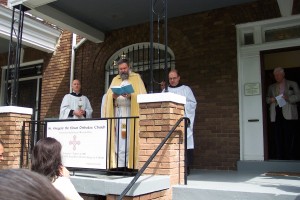 Rogation days – days set aside by the Church for petitions to God and his saints while the Litany is sung in procession and prayers are offered particularly for the bounty of the earth and protection against calamities of all sorts – have been a part of Christian observances from very early times.
Rogation days – days set aside by the Church for petitions to God and his saints while the Litany is sung in procession and prayers are offered particularly for the bounty of the earth and protection against calamities of all sorts – have been a part of Christian observances from very early times.
It is believed that the first Rogations days were a “baptizing” of a Roman pagan practice of making supplications for good crops on April 25 of each year. St. Gregory the Great strengthened and expanded this practice when the Roman people were besieged by a terrible plague which brought sudden and unexpected death to many of the population. He organized the orders of people in the processions (clergy, monastics, children, lay people) and called for the cross to be carried and bells to be rung. The 13th-century Golden Legend describes the processions in this way:
In this procession we carry the cross and ring the bells to make the devils flee in terror; for just as a king in the midst of his army has the royal insignias, namely, trumpets and standards or banners, so Christ the eternal King in the midst of his Church militant has bells for trumpets and crosses for standards. Any tyrant would be terrified if he heard in his land the trumpets and saw the banners of some powerful king, his enemy; and so the demons who are in that murky air are sore afraid when they hear Christ’s trumpets – the bells – and catch sight of his standards – the crosses.
The Rogation days which are observed prior to Ascension Day were established by Bishop Mamertus of Vienne about the year 470, also in response to calamity. The area was experiencing frequent earthquakes and an Easter Sunday fire destroyed the king’s palace. So the bishop called for a fast and three days of processions with the singing of the Litany and prayers for the intercessions of the saints. The Golden Legend also describes the use of the Trisagian (Holy God, Holy, Mighty, Holy Immortal, have mercy on us) as part of the Litany on these days. In Western liturgical practice today, this prayer is used only on Good Friday.
These latter Rogation days (called the “Minor Rogations” as compared to the “Major Rogation” of April 25) were soon adopted in other parts of the West. The Fifth Council of Orleans in 511 established the practice throughout Gaul; St. Augustine of Canterbury brought the practice to Britain after learning of it in Gaul, and the Council of Clovesho in 747 called for the practice throughout England. Pope Leo III (795-816) approved the use of these Rogation Days in Rome.
Through the centuries, Rogation processions evolved in more secular directions (such as the “beating of the bounds” in England, marking the geographic boundaries of parishes). The Roman Catholic church removed Rogation observances from the calendar in the 1970’s but permission has lately been given to revive such practices.
The world continues to experience calamities of all sorts (earthquakes, wildfires, epidemics) and the secular world recognizes and marks the delicate balance between man and nature in such occasions as the recent “Earth Day”.
Western Orthodox Christians continue the Church’s ancient observance of Rogation days, now most often having a procession on the 5th Sunday after Easter following Mass. We ask for the prayers of the saints to protect us from calamities and to grant us the benefit of the fruits of the earth. All ye holy men and women of God, intercede for us.